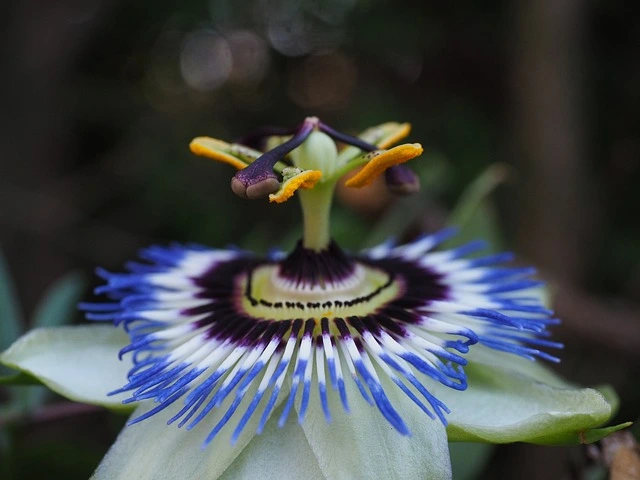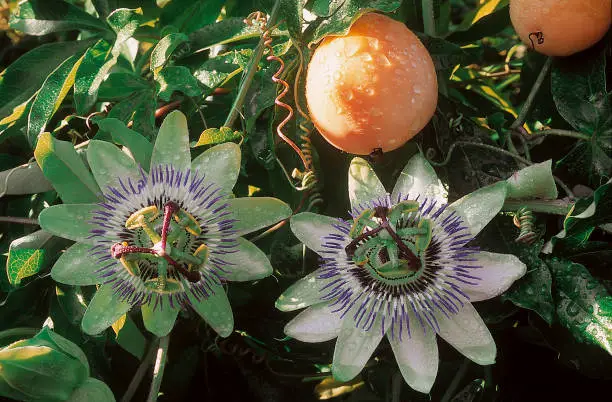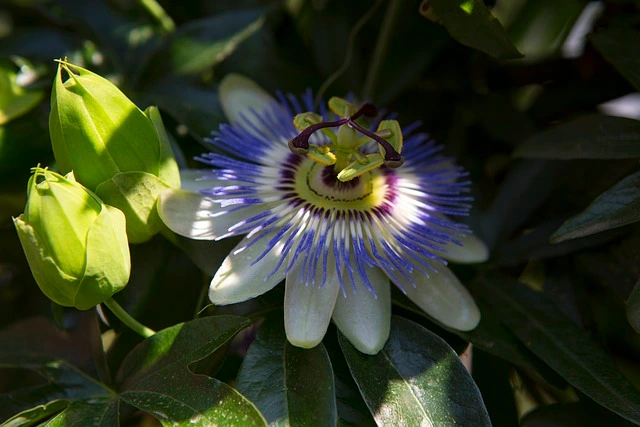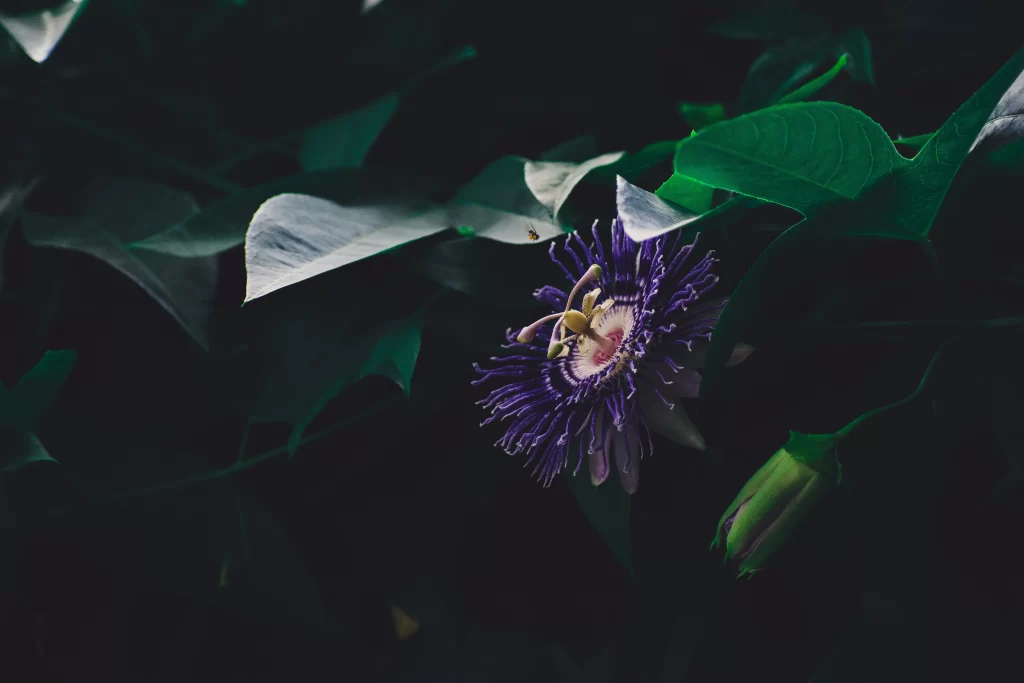Blue Passionflower, also called Passiflora caerulea, is an excellent plant that nature fans and gardeners love. This beautiful vine comes from South America and is part of the Passifloraceae family. It’s known for its pretty appearance and is a tendril vine that spreads a lot. The blue passionflower vine has thin stems and leaves with three parts and sharp edges. Its flowers are light pink, and its fruits are round or egg-shaped. However, it’s great for climbing structures like arbours and verandahs. Moreover, when its fruits are ripe, you can eat them. Some experiments suggest that it could help with problems like anxiety, sleeping issues, and even cancer.

Read: Tiger Lily: Care, Significance, and Medicinal Uses Unveiled!
Essential Characteristics of Blue PassionFlower
Specific characteristics can vary depending on climate, soil type, and growing conditions. If you plan to cultivate Blue Passionflower, it’s a good idea to research and adapt care practices to your specific location and environment.
| Characteristic | Details |
| Sun exposure | Full sun to partial shade |
| Hardiness | USDA Zones 8-11[1]Compare different species of Passiflora Passion Flowers. Read |
| Height | 6 – 9 meters (20 – 30 feet) or more |
| Flowering time | Late spring to early summer |
| Spread | Spreads widely, covering several feet up to 0.9-1.8 feet. |
| Flower Color | Blue or violet |
| Fruit | Small oranges when ripe are edible |
| Growth Habit | Climbing vines that cover structures |
| Pollinators | Attracts bees and butterflies |
Read: Water Lily: Dive into the Allure of Aquatic Beauty!
The Origins of Passiflora Caerulea
Passiflora caerulea has a long and storied history that dates back centuries. Spanish explorers first discovered it in the 1529th century during their voyages to the New World. The plant’s striking appearance and vibrant blooms immediately caught their attention. The plant’s scientific name, Passiflora caerulea, is derived from the Latin words “passio“, meaning passion, and “flos”, meaning flower. Passionflowers belong to a group called Passiflora, with around 500 types of them[2]R, Sita Sharan, et al., Passiflora Incarnata Linn: A Review on Morphology, Phytochemistry, and Pharmacological Aspects, Phcog Rev. Vol, 3, Issue 5, 186-192, 2009. Read. They mostly live in warm and tropical places. However, people from countries like West India, Mexico, the Netherlands, South America, Italy, and Argentina used these plants in their traditional medicines long ago.
Salient Features of Passiflora Caerulea
A climbing vine with a height of 30 feet, Passiflora caerulea can reach impressive heights. Its distinctive leaves are deeply lobed and can vary in size, ranging from 3 – 9 inches in length. The flowers of Passiflora Caerulea are one of its most captivating features, with their complicated structure and mesmerizing colors. The petals are a beautiful hue of blue, while the center of the flower is adorned with a striking arrangement of filaments and stamens.

Read: The Black Pagoda Lipstick Plant: Traditional Medicine and Cosmetics
The Blue Passionflower, or Passiflora caerulea, stands out from other plants for several reasons[3]Blue Passionflower Guide. Read. Here are some of its characteristics and salient features:
Flowers
Passiflora caerulea produces striking and complicated flowers. These flowers have a blue or violet hue and consist of several layers of petals and filaments, creating an eye-catching appearance.
Fruits have polyphenols and flavonoids that can fight off harmful bacteria in our bodies. People use these fruits to help with problems like Alzheimer’s, cancer, Parkinson’s, and liver issues. The Blue passionflower fruit peel has some good stuff, like flavonoids, phenolics, and other things. These things can help with high blood sugar and heart issues.
The plant produces small, egg-shaped fruits that are typically orange when ripe. While not widely consumed, these fruits are edible and can be enjoyed in moderation.

Climbing Growth
Passiflora caerulea is a tendril vine that wraps its long stems around arbours and verandahs, covering them all. It is famous for beautifying outdoor spaces because of its growth habit.
The unique combination of its intricate flowers, lobed leaves, and climbing growth habit sets Passiflora caerulea apart as a captivating and visually appealing plant.
The Advantages of Passiflora Caerulea for Health and Wellbeing
Passiflora caerulea is not only beautiful but also offers numerous health benefits. Throughout history, the plant has been used for treating a variety of diseases. However, compounds in its leaves and flowers are sedatives and calming, which makes them natural remedies for anxiety and insomnia. Passiflora caerulea is also rich in antioxidants, which can help boost the immune system.
P. caerulea, or blue passion flower, is a tendril vine that wraps over surrounding things and can get long, over 10 meters sometimes. It’s from South America, and people have used its fruits and leaves for medicine. [4]R, Smruthi, et al., The active compounds of Passiflora spp and their potential medicinal uses from both in vitro and in vivo evidences, J. Adv. Biomed. & Pharm. Sci. 4 (2021) 45-55 . Read

Passiflora Caerulea Plant calendar throughout the year
Various factors, including local climate and growing conditions, can influence the specific timing of these events. [5]Passiflora Plant calendar. Read Passiflora caerulea’s plant calendar throughout the year:
| Season | Months | Activities and Events |
| Spring | March-May | New leaves and stems growth, buds appear |
| Summer | June – August | Blue flowers bloom, pollination, fruit development |
| Fall | September – November | Fruits ripen, leaves change color |
| Winter | December – February | Slowed growth, leaf changes (varies) |
Passiflora’s toxic nature
Passiflora, including Passiflora caerulea (Blue Passionflower), generally considers non-toxic and safe for human consumption. However, some species of Passiflora can produce compounds that might be toxic in large amounts. The level of toxicity can vary between different species and parts of the plant, such as leaves, stems, and unripe fruits.
Passiflora plants contain substances like cyanogenic glycosides, which can release cyanide when broken down. Before consuming any plant material, please exercise caution and conduct proper research. Many Passiflora species are edible, while other species use them as herbal remedies.

Passiflora caerulea is genuinely a remarkable plant that captivates all who encounter it. In addition to its rich history and stunning characteristics, Passiflora caerulea can be used for a variety of health benefits. Additionally, it could be a new option for treating problems like anxiety, insomnia, coughs, and cancer. However, the realistic fact is that this plant is becoming rare, so we should also try to grow it and take advantage of its glance blue crown beauty.
References
| ↑1 | Compare different species of Passiflora Passion Flowers. Read |
|---|---|
| ↑2 | R, Sita Sharan, et al., Passiflora Incarnata Linn: A Review on Morphology, Phytochemistry, and Pharmacological Aspects, Phcog Rev. Vol, 3, Issue 5, 186-192, 2009. Read |
| ↑3 | Blue Passionflower Guide. Read |
| ↑4 | R, Smruthi, et al., The active compounds of Passiflora spp and their potential medicinal uses from both in vitro and in vivo evidences, J. Adv. Biomed. & Pharm. Sci. 4 (2021) 45-55 . Read |
| ↑5 | Passiflora Plant calendar. Read |



